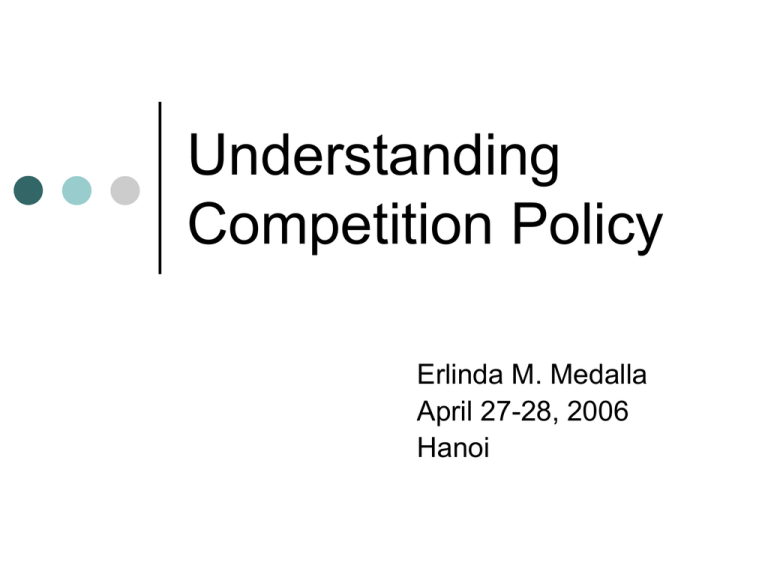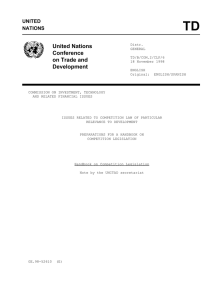Competition Policy & Law for the Philippines
advertisement

Understanding Competition Policy Erlinda M. Medalla April 27-28, 2006 Hanoi Enhancing efficiency and optimizing welfare In general, market discipline (where there is effective competition) leads to efficiency and welfare optimization In certain cases, there is need to discipline the market– where there are deviations from competition due to errant firm behavior Cases of inherent market imperfection– where there is need for government regulation to achieve competitive-like outcomes What is competition policy for? Promoting (effective) competition Making markets contestable Discipline errant firm behavior (restrictive business practices) And where market fails (natural monopolies) enforcing competition rules (regulation) to produce competitive-like outcomes Objective: eliminate rents and maximize overall welfare Major areas of competition policy Anti-trust law governing firm behavior to ensure fair competition Abuse of dominant position, restrictive agreements, M&A Consumer protection (from unfair competition practices) Regulation of natural monopolies Review of government policies impinging on competition Competition and Regulation Competition law to govern: Restrictive trade practices arising from: Abuse of dominant position Agreements Mergers and acquisition Consumer protection- unfair trade practices Regulation of natural monopolies Types of Restrictive Business Practices Exclusionary abuse Deliberate act of the firm (or group of firms) to exclude potential firms from entering the market by means other than becoming more efficient. Exploitative abuse Abuse of market power where firms would limit outputs thru some deliberate means in order to increase prices and extract monopoly rents. Examples of Restrictive Business Practices Exploitative abuse; Cartel Agreements to fix prices, outputs Agreement to divide markets Collusive tendering (bid rigging) Predatory pricing Exclusionary abuse: Resale price maintenance, Exclusive dealing, tying sales, designed to limit competition from rival firms What needs to be done? Creating a “competition culture” Belief in markets and willingness to be subject to market discipline Awareness of rights and knowledge about anti-competitive acts “Profit with honor” Capacity building Crafting a “good” competition law a “living” law conducive to developing national competition authority which is respected and credible. No one unique model US- Strong anti-trust law enforcement and sector regulation Europe- the mandate driven division of labor between sector regulators and competition authorities Korea- coordination between KFTC and sector regulator– same competition principles Australia- integration of regulation and antitrust Key elements of competition law Clear definitions Clear rules to identify prohibited actions (e. g. per se prohibitions),& appropriate remedies and/or penalties Rules on mergers & acquisitions Research function and Investigative powers Independent competition authority? Key elements of competition law Mechanism for reviewing existing (and proposed) government policies & regulations as they impact on competition Provisions for transition– Capability building Start small Relationship between competition authority and sector regulators Education, information and advocacy functions Some major concerns at early stages Ensuring that it would not be just another regulatory layer Provisions on prohibited acts— On implementing body— How to be crafted to lessen ambiguity How to create a credible, respected authority Need for learning period and capability building Need for information, education & advocacy Thank you for your attention.







